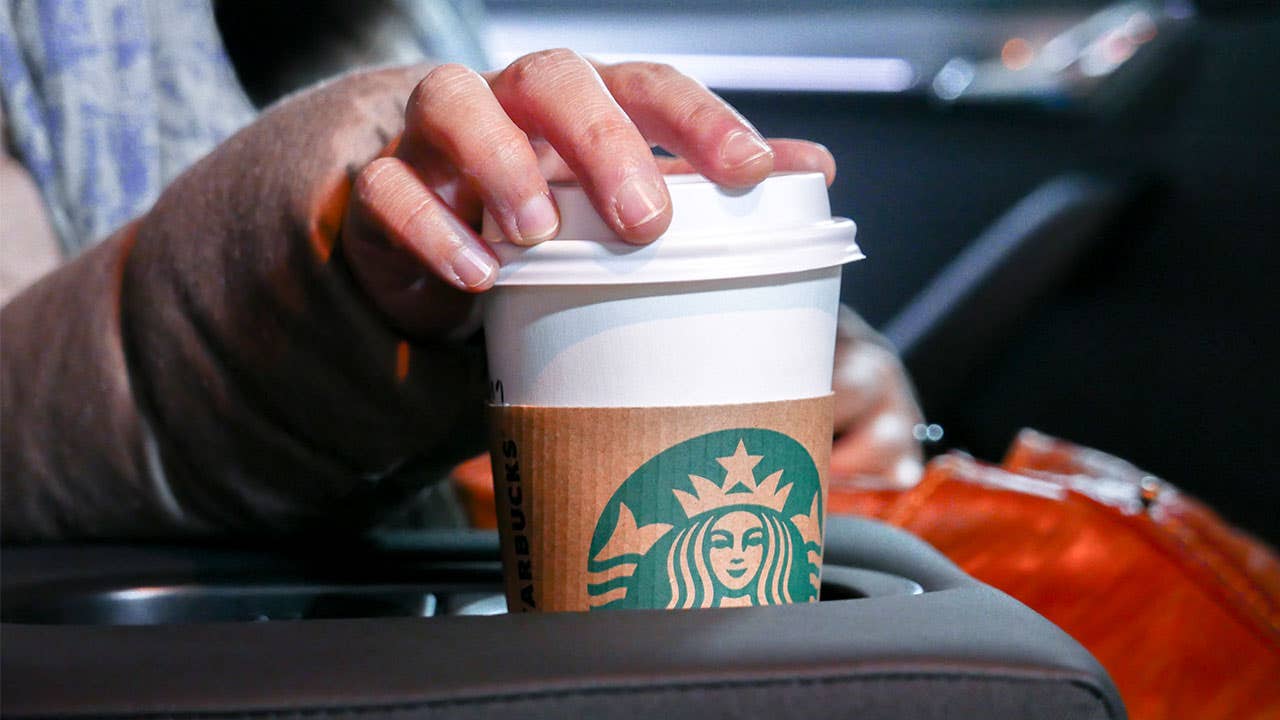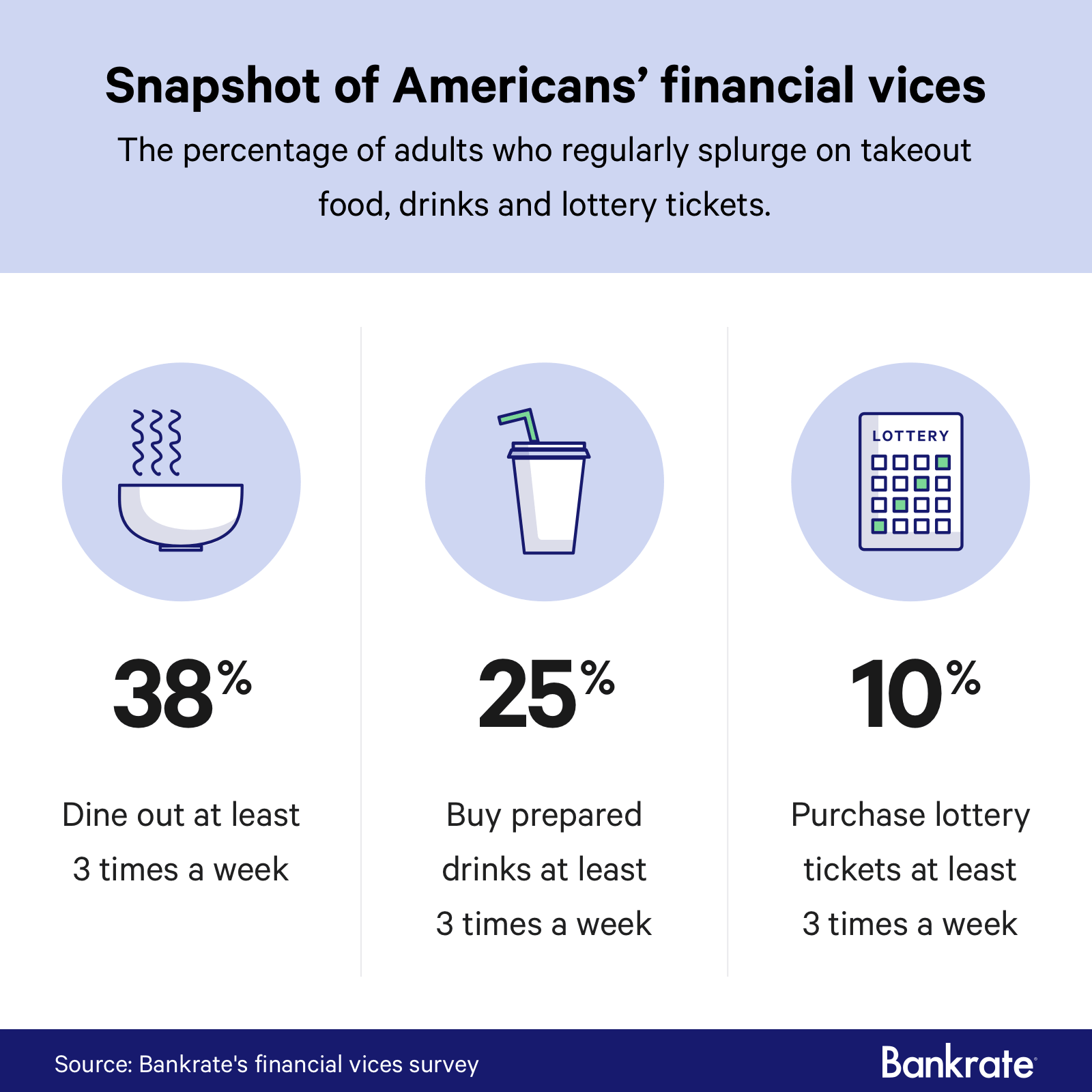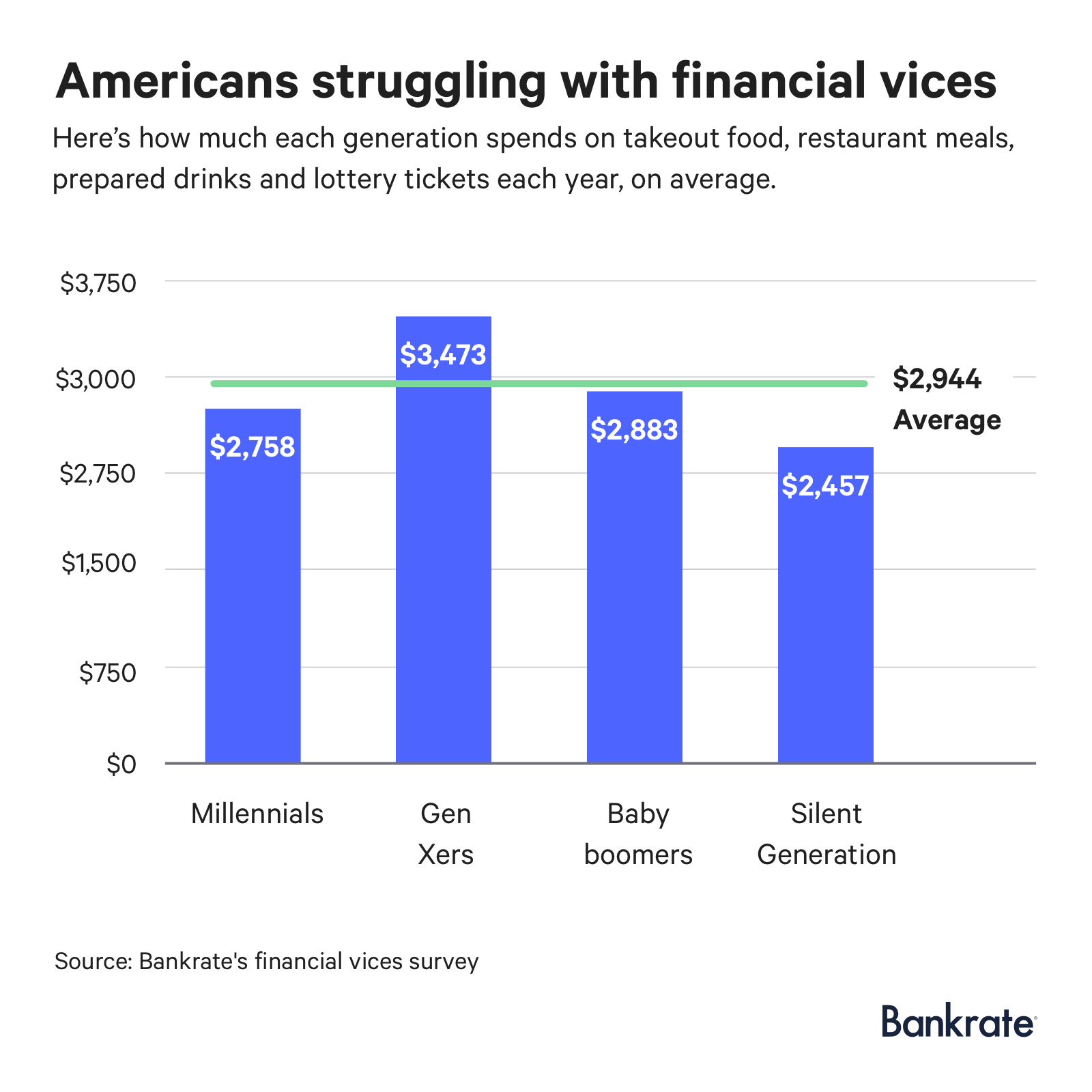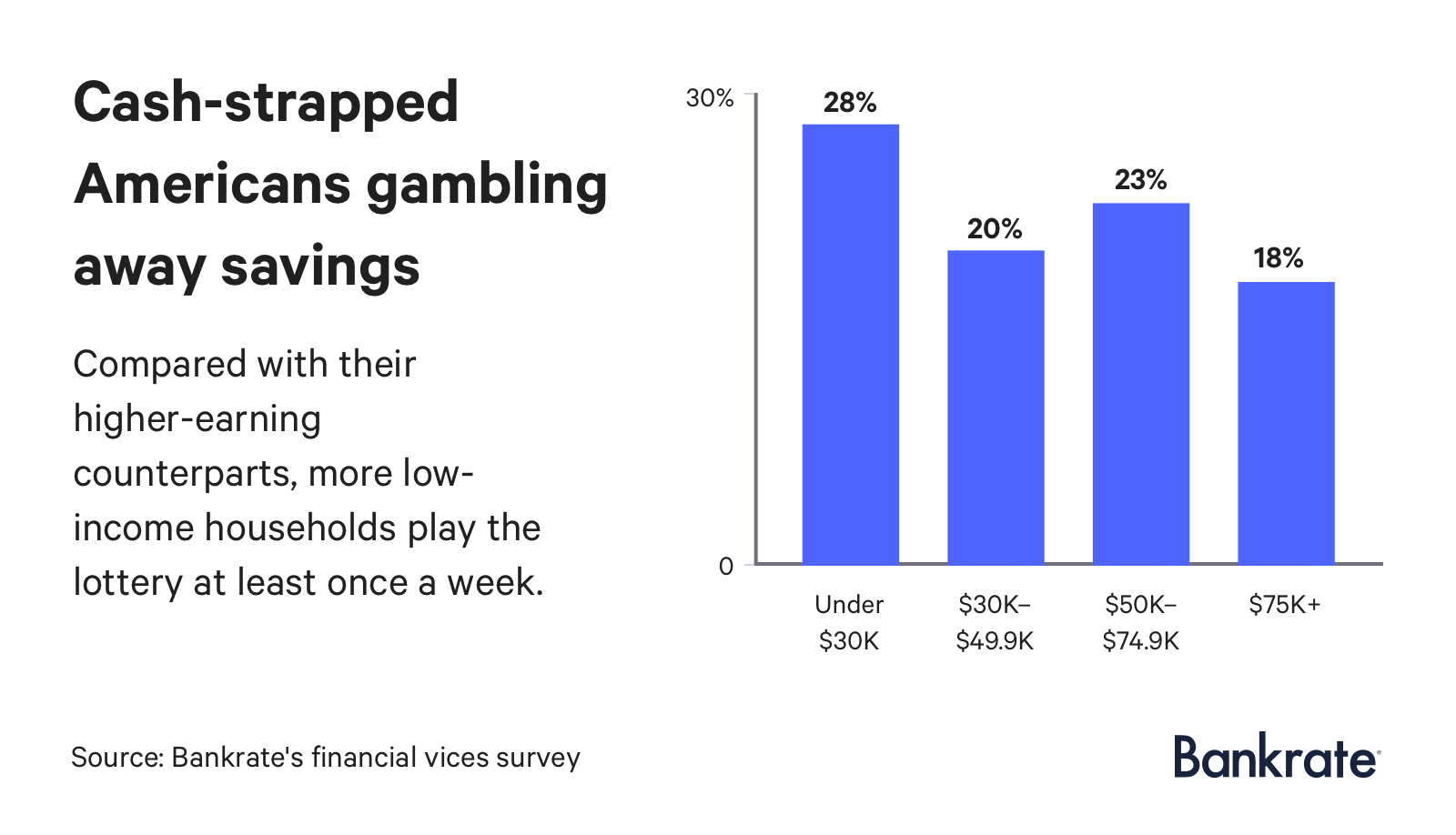Adding it up: Here’s how much Americans spend on financial vices


Whether it’s alcohol, cigarettes or junk food, we all indulge in something we know we probably shouldn’t.
While some vices may be hazardous to our health, others can potentially have a negative impact on our finances.
Sarah Gmyr, for example, usually spends about $200 per week on restaurant food and prepared drinks. She’s not going into overdraft every month, she says, but that’s money she’s perhaps spending unnecessarily.
“It’s kind of shocking when I talk about it and think about (it) a little bit more because it’s like, OK, that money could be going to retirement, could be going to a high-yield savings (account),” says Gmyr, a 40-year-old consultant in Washington, D.C.
Spending on vices, by the numbers
Gmyr isn’t alone. Each week, the typical American on average buys takeout or restaurant food 2.4 times, buys 2.5 prepared beverages (like smoothies and brewed coffee) and spends $17 on lottery tickets, according to a Bankrate survey. In total, Americans spend $2,944 a year on these financial vices, on average.
The bulk of that cost comes from dining out. Americans spend an average of $2,443 a year on restaurant meals and takeout food, and 38 percent dine out at least three times a week.
Households in the lowest-income bracket (earning under $30,000 a year) spend 13 percent of their income on the financial vices included in the study. Meanwhile, the highest-earning households (with an annual income of $75,000 or more) spend just 2.6 percent of their income on prepared drinks, restaurant food and lottery tickets.

Gmyr says she’s making an effort to cut back on discretionary spending.
After covering the cost of some unexpected expenses — namely, a sick dog and a house flooding — her rainy-day fund was depleted within a matter of weeks. At this point, she doesn’t even have three months’ worth of emergency savings.
“I made a conscientious choice this week not to buy coffee,” Gmyr says. “I’m feeling very vulnerable at the moment, so I went and got sort of the overnight coffee stack and I’ll make my own coffee at home and the same with lunch, you know, because I am having to face this reality head on right now, and it’s kind of scary.”
So, is spending too much money on lattes and fast food a problem? The answer varies depending on your financial circumstances.
“If you’ve got those savings habits in place, then the daily latte is not the problem and you shouldn’t feel guilty about it,” says Greg McBride, CFA, Bankrate’s chief financial analyst. “But on the other hand, if you’re not saving, if you’re struggling to pay bills on time every month, if you’re incurring debt and if you regularly run out of money before you run out of month, then the daily latte is the first place to start in terms of creating some breathing room for yourself financially.”
Spending more, saving less
Gen Xers (ages 38 to 53) like Gmyr spend more money on prepared drinks, restaurant food and lottery tickets than members of any other generation ($3,473).
“Things like restaurant food and prepared beverages, a lot of that is just a byproduct of your busy life,” McBride says. “The Gen X years are years where you’ve been in the workforce for a couple of decades and so your earnings have gone up, but you’re at that stage of family, mortgage payments, kids, soccer tournaments. And so you’re busier than you’ve ever been.”
But spending so much money on discretionary items could be an issue for many Gen Xers without an adequate savings cushion. Recent Bankrate surveys found that 42 percent of them aren’t comfortable with the size of their emergency funds, and 64 percent are saving 10 percent of their annual income or less.

Having enough emergency savings to cover at least six months’ worth of expenses is generally ideal. But how much you need to save (whether that’s six months’ or nine months’ worth of expenses) will depend on various factors, including your employment status and whether your partner also works (and saves for the unexpected).
Figuring out how much you should be spending on coffee and restaurant food can be even more difficult. Popular budgeting models recommend setting aside a specific amount of money for discretionary items. The 50/20/30 rule, for example, suggests spending 30 percent of your income on “wants,” which would include lottery tickets, movie tickets and other similar expenses.
But some financial experts say that’s the wrong approach.
You should carefully track your spending and create a budget based on your personal financial goals and priorities, says Lisa Weil, a certified financial planner based in Seattle.
Consider setting aside enough money to cover bills and emergencies first, says Gordon Achtermann, founder of Your Best Path Financial Planning in Annandale, Virginia. Make room in your financial plan for long-term goals, too.
“Whatever is left over can go toward vices,” Achtermann says.
Many people are taking a gamble
Lottery tickets are a big financial vice, particularly for the poorest Americans. Among households in the lowest-income bracket, 28 percent play the lottery at least once a week. That’s the case for just 19 percent of households with higher earnings.
Within a year, that means financially strapped households spend $412 on lottery tickets, nearly four times the amount that the highest-earning households admit to spending.
“That works out to $34 a month,” McBride says. “That’s a substantial enough figure to plug a hole in your monthly budget. That could be the difference between a bill being past due or paid on time, the difference between incurring debt or paying cash for a necessity or the difference between saving or not saving.”

In a recent blog post, Michael Kitces, a certified financial planner, argues that the lowest-income households shouldn’t bother reducing their discretionary expenses and cutting out their Starbucks coffee; they’re not making much money to begin with. For these folks, finding ways to boost their income is the only strategy that makes sense, he says.
Most middle-income households with spending challenges are better off putting more effort into reducing their housing and transportation costs, Kitces says, which make up a larger portion of their budgets.
Upper-income households have the most discretionary income flexibility, Kitces says. So for them it makes sense to consider spending less on coffee and takeout food if it’s keeping them from meeting their financial goals.
Quentara Costa, founder of Powwow, a financial planning practice in North Andover, Massachusetts, says not to go overboard in thinking that reducing discretionary spending will leave you with enough money to substantially improve your financial situation.
“Let’s say someone our age didn’t get coffee for three years. So what they save $10,000 for like a down payment to a house? Depending on where you are, that’s nothing,” Costa says. “To me, it’s just silly when they talk about that and I’m not trying to trivialize it, but you’d have to give up a lot of things for it to really make a meaningful impact.”
Rein in careless spending
If you don’t have enough money in your rainy-day fund or you’re looking for an easy way to boost your savings, spending less on coffee, lottery tickets and restaurant food could help to an extent.
Strategies like taking advantage of coffee at the office or making more meals at home can pay off. And if you’re itching to play the lottery, consider getting a prize-linked savings account through a credit union or an app like Long Game. You’ll be able to save money and potentially win a cash prize.
More importantly, you should get into the habit of saving money regularly, McBride says. Have funds automatically taken out of your paycheck and deposited into a high-yield savings account and either an IRA or an employer-sponsored retirement account.
The study was conducted online in GfK’s Omnibus using the web-enabled “KnowledgePanel,” a probability-based panel designed to be representative of the U.S. general population, not just the online population. The study consisted of 1,000 nationally representative interviews conducted between Aug. 17-19, 2018 among adults aged 18+. The margin of error is +/-3 percentage points.




